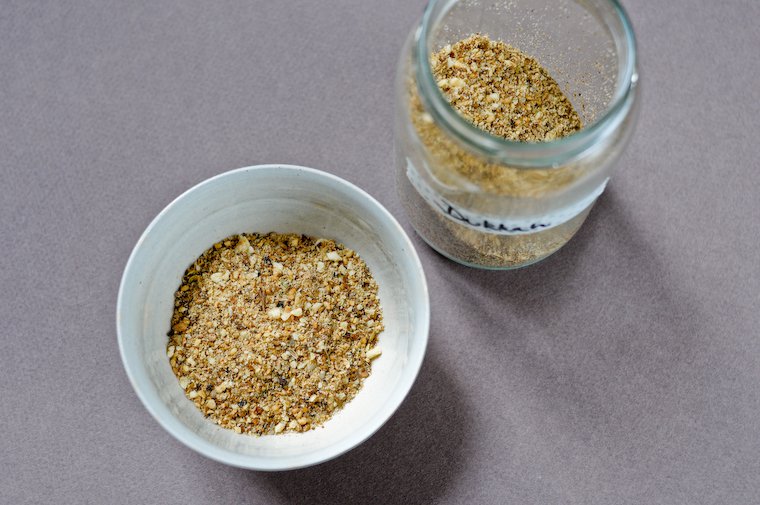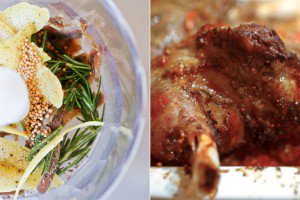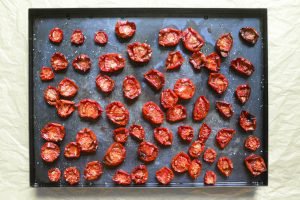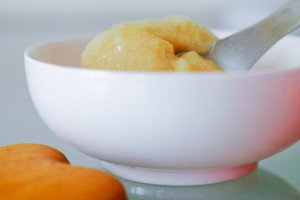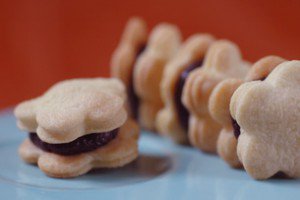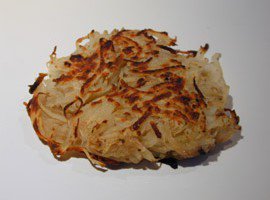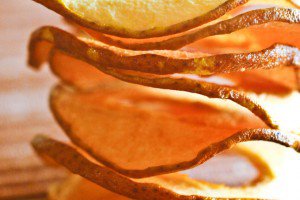I first learned about dukkah three years ago, when I had the incredible good fortune of traveling to Australia for a writers’ festival. I spotted that Egyptian mix of nuts and spices again and again, in fine foods stores and on restaurant menus, and naturally, I was intrigued.
Dukkah — also spelled duqqa or dukka — is made with nuts (most commonly hazelnuts, sometimes pistachios or almonds) and seeds (cumin, sesame, coriander, fennel), as well as pepper berries, salt, and sometimes dried herbs and chili pepper. The ingredients are lightly toasted, then ground together into a not-too-fine powder.
Dukkah is typically used as an interactive appetizer involving bread, a shallow cup of olive oil, and another of dukkah: you tear off a piece of bread, dip it lightly in the oil, then in the dukkah, and eat. It is very good.
I brought a jar of dukkah back from Australia then, but quickly realized nothing was stopping me from making my own, which I enthusiastically did. My enthusiasm was somewhat tempered, however, by the fact that I was using a mortar and pestle. Traditional though they may be, these tools require a not insignificant amount of huile de coude (yes, the French use extra-virgin elbow oil, it has more flavor than elbow grease).
You tear off a piece of bread, dip it lightly in the oil, then in the dukkah, and eat. It is very good.
But my dukkaphilia was rekindled when I acquired an electric spice grinder last year — actually, it’s a repurposed coffee grinder — and discovered I could have freshly mixed dukkah in seconds, with very little caloric expenditure.
I’ve been making it a lot lately, and it’s my new favorite boy-this-just-goes-with-everything-doesn’t-it ingredient. In fact, I’m still looking for things I can’t do with it.
In addition to the classic bread-oil-dip use described above, I’ve been adding it to roasted vegetables and grated carrot salads, I’ve been seasoning hard-boiled eggs with it (dip and bite, dip and bite) and using it as a furikake to make onigiri (it works really well), and I’ve flavored the dough for bread rolls with it. Maxence likes to sprinkle it on a slice of buttered pain au levain at breakfast, and now that the first radishes are making their appearance (they are! isn’t it exciting?), I plan to substitute dukkah for the salt in croque-au-sel radishes.
There is no single formula for dukkah; it is one of those preparations for which there may be as many versions as there are cooks. I’m giving you the recipe below as an illustration of what works for me, but you can play around with the different ingredients to find the balance of flavors that appeals to you the most. (And when you do, I hope you’ll report back and share.)

Have you tried this? Share your pics on Instagram!
Please tag your pictures with #cnzrecipes. I'll share my favorites!
Ingredients
- 30 grams (1 ounce, 1/4 cup) hazelnuts
- 30 grams (1 ounce, 1/4 cup) shelled pistachios (unsalted)
- 4 tablespoons sesame seeds
- 2 tablespoons coriander seeds
- 2 tablespoons cumin seeds
- 1 teaspoon fennel seeds
- 1 teaspoon black pepper berries
- 2 teaspoons dried thyme
- 1 teaspoon salt
Instructions
- Toast the hazelnuts and pistachios in a dry skillet, and set aside. Toast the seeds and berries (from sesame to black pepper) in the skillet for 2 minutes, until fragrant, shaking the skillet frequently. Let cool completely.
- Combine all the ingredients, and grind to a coarse powder in an electric grinder or with a mortar and pestle. You may have to proceed in two batches.
- Pour into a jar, close tightly, and keep somewhere cool and dry.


